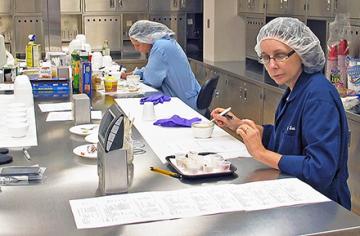Batter Up: Catfish Fillets for Baking

Research food technologist Karen Bett-Garber, right, and food technologist Jeanne Lea perform a sensory panel taste test of catfish samples at the Southern Regional Research Center sensory lab in New Orleans, LA, after preparing and giving samples to other panel members to be judged and analyzed for crispness and other texture characteristics of baked catfish. (John Bland, D4171-1)
Ready-to-fry breaded catfish fillets make a quick and tasty meal, but interest is growing in healthier alternatives like breaded or battered catfish products that can be baked.
At last count in 2012, more than 161 million pounds of catfish were processed—many of which became battered catfish products for frying. The catfish industry produces a significant number of battered catfish products for deep-fat frying, but few are designed for baking.
The most common problem with battered fish products made for baking is that the texture is not as crisp as that of fried fish, says John Bland, a chemist with the Agricultural Research Service’s (ARS) Southern Regional Research Center (SRRC) in New Orleans, Louisiana.
Par frying—partially frying food but not browning it, so that it must be cooked again before serving—could be used to improve texture properties of baked foods. However, this would increase equipment and operation expenses and result in higher calories from the adsorbed oil in the product, Bland says. “A baked product that is not par fried, but has the texture properties of a fried product, has the potential to meet purchasing specifications for food service operations such as school districts, health care facilities, and government purchases,” he adds.
Bland and his colleagues in SRRC’s Food Processing and Sensory Quality Research Unit explored ways to prepare battered catfish for baking that’s tasty, crispy, and more appealing to consumers. In a recent study, they cut frozen catfish fillets into strips and battered them with rice, corn, and wheat-based commercial flours. Some of the catfish strips were par fried before baking while others were not.
All catfish strips were analyzed and judged by a trained sensory panel for oil uptake, crispness, and other texture characteristics of baked catfish. The oil content of par-fried and baked fillets that were battered with corn and rice flour was three times higher than the oil content of non-par-fried baked fish, while the wheat batter showed a smaller increase. However, batters on the catfish strips that were par fried before baking had better texture characteristics than those in baked-only products, with values for attributes like crispiness, hardness, or flakiness being twice as large.
“Overall, our research showed that baked battered catfish had a lower oil content but a less desirable texture than catfish that’s par fried first and then baked,” Bland says. “These types of catfish products designed for baking could potentially be acceptable to health-conscious consumers as well as food service operations.”—By Sandra Avant, ARS Office of Communications.
You May Also Like:

